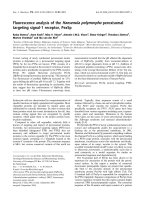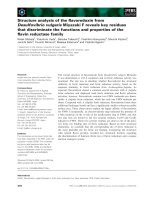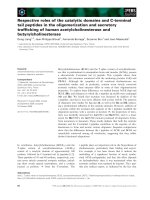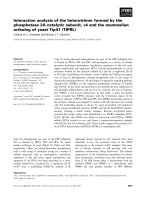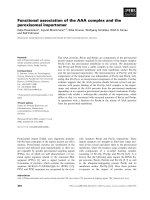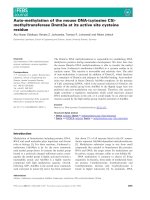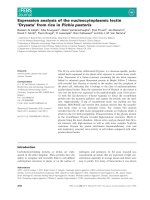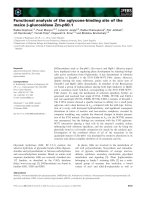báo cáo khoa học:" Rasch analysis of the Hospital Anxiety and Depression Scale (HADS) for use in motor neurone disease" pot
Bạn đang xem bản rút gọn của tài liệu. Xem và tải ngay bản đầy đủ của tài liệu tại đây (666.36 KB, 8 trang )
RESEARCH Open Access
Rasch analysis of the Hospital Anxiety and
Depression Scale (HADS) for use in motor
neurone disease
Chris J Gibbons
1,2*
, Roger J Mills
1
, Everard W Thornton
2
, John Ealing
3
, John D Mitchell
4†
, Pamela J Shaw
5
,
Kevin Talbot
6
, Alan Tennant
7
and Carolyn A Young
1
Abstract
Background: The Hospital Anxiety and Depression Scale (HADS) is commonly used to assess symptoms of anxiety
and depression in motor neurone disease (MND). The measure has never been specifically validated for use within
this population, despite questions raised about the scale’s validity. This study seeks to analyse the construct validity
of the HADS in MND by fitting its data to the Rasch model.
Methods: The scale was administered to 298 patients with MND. Scale assessment included model fit, differential
item functioning (DIF), unidimensionality, local dependency and category threshold analysis.
Results: Rasch analyses were carried out on the HADS total score as well as depression and anxiety subscales
(HADS-T, D and A respectively). After removing one item from both of the seven item scales, it was possible to
produce modified HADS-A and HADS-D scales which fit the Rasch model. An 11-item higher-order HADS-T total
scale was found to fit the Rasch model following the removal of one further item.
Conclusion: Our results suggest that a modified HADS-A and HADS-D are unidimensional, free of DIF and have
good fit to the Rasch model in this populatio n. As such they are suitable for use in MND clinics or research. The
use of the modified HADS-T as a higher-order measure of psychological distress was supported by our data.
Revised cut-off points are given for the modified HADS-A and HADS-D subscales.
Introduction
The Hospital Anxiety and Depression Scale (HADS) [1]
is a reliable and potentially valid [2,3] measure for
detecting depression and anxiety. The scale was
designed to exclud e measurement of somatic symptoms
in medical outpatients; making it potentially suitable for
use with motor neurone disease (MND) patients.
Due to the scale’s apparent suitabil ity, the HADS has
been widely used in MND research for assessing states
of anxiety and depression [4-7]. However, questions
have been raised as to the suitability of the HADS
depr ession subscale with MND patients as two previous
studies [6,7] have omitted item D8 “ I feel as though I
am slowed down”, on the reasonable assumption that
responses to this item would be confounded by physical
impairment. Whilst this change had clinical and face
validity, in neither study was it accompanied by appro-
priate statistical or psychometric analysis to justify the
alteration.
The Rasch model [8], a modern psychometric
approach, ensures that the fundamental scaling proper-
ties of an instrument are assessed alongside traditional
psychometric assessments of reliability and construct
validity. The model operationalises the formal axioms of
measurement [9] (order, unidimensionality and additiv-
ity), so allowing interval level data to be obtained from
questionnaires. Rasch validation of the HADS has been
prov en useful in other clinical settings, such as rehabili -
tation [10] and Parkinson’s disease [11].
The current study is a modern psychometric assess-
ment of the HADS anxiety (HADS-A) and depression
(HADS-D) subscales to assess the dimensionality, item
* Correspondence:
† Contributed equally
1
Walton Centre for Neurology and Neurosurgery, Lower Lane, Liverpool, UK
Full list of author information is available at the end of the article
Gibbons et al. Health and Quality of Life Outcomes 2011, 9:82
/>© 2011 Gibbons et al; licensee BioMed Central Ltd. This is an Open Access article distributed under the terms of the Creative Comm ons
Attribution License ( s/by/2.0), which permits unrestricted use, distribution, and reproduction in
any medium, provided the original work is properly cited.
suitability, reliability, scaling assumptions and internal
consistency of the scales for use with MND patients.
The analysis included evaluation of differential item
functioning (DIF) by gender and age. I n addition, the
HADS total score (HADS-T) was investigated as a
potentially valid measure of psychological distress in this
population.
Methods
Main data collection
The psychometric and scaling properties of the HADS
were assessed among 298 patients recruited from five
regional MND care centres in the United Kingdom: The
Walton Centre for Neurology and Neurosurgery i n
Liverpool, Preston Royal Hospital, Oxford John Radcliffe
Hospital, Salford Hope Hospital, a nd Sheffield Royal
Hallamshire Hospital. Participants all had a diagnosis of
MNDfromaneurologistwithexpertiseinMND.
Patients were unselected for age, sex, and disease pre-
sentation or disability status. Questionnaires were either
handed out during a routine clinic appointment or sent
to the patients’ home over a period of twelve months,
along with a newsletter describing the research activities
of their local care centre. Where patients were unable to
complete the questionnairesbythemselvesanurseor
caregiver was allowed to a ct as a scribe. Informed con-
sent was given by each participant.
Ethical permission was granted for this study from
relevant hospital committees in the U.K. (Hammersmith
05/Q0401/7 and Tayside 07/S1402/64), and local
research governance committees at all participating
sites.
Rasch Analysis
To evaluate the scaling properties and construct validity
of the HADS, the Rasch measurement model was used
[8]. Rasch analysis is a probabilistic mathematic model-
ling technique used to asse ss properties of outcome
measures. Where data are shown to accord with model
expectations, the internal construct validity of the scale
is supported, and a transformation of ordinal data to
interval scaling is possible [12].
For Rasch analysis, sample sizes requirements are
influenced by scale targeting. For a scale that is well tar-
geted (i.e. 4 0-60% endorsement rates for dichotomous
items), a sample size of 108 will give accurate estimates
of person and item l ocations (99% confidence of loca-
tions being within 0.5 l ogits). A sample size of 243 will
provide accurate estimations of items and person loca-
tions irrespective of scale targeting [13].
Analyses used to assess whether the scale conformed
to Rasch model expectations are briefly explained below.
A comprehensive review with a more detailed
explanation of the Rasch a nalytical process may be
found elsewhere [10].
Rasch Unidimensio nal Measurement Model 2020
(RUMM2020) software (Version 4.1, Build 194) was
used for the Rasch analyses presented in this study [14].
1) Fit to the Rasch model
Rasch model fit is primarily indicated by a non-signifi-
cant fit statistics, indicating that the scale does not devi-
ate from model expectations. For example, both
summary and individual item chi-square statistics
should be non-significant, after adjusting for multiple
testing. In addition, both person and item fit are
assessed by their residual mean values. This examines
the differences between the observed data and what is
expected by the model for each person and each item
estimate. At the summary level perfect fit is represented
by a mean of zero and a SD of ± 1, while at the indivi-
dual level for persons and items, a residual value
between ± 2.5 is appropriate.
2) Item difficulty and person ability
Estimates of a location on a common metric are pro-
vided for both persons (ability) and items (difficulty). In
the context of the health sciences, ‘ab ility’ may be
understood to represent the amount the person has of a
given symptom, trait or feeling and difficulty may be
understood to represent the magnitude of the symptom,
trait or feeling represented by the item. For example, an
item that reflected the sentiment that life was no longer
worth living would be expect ed to represent a high l evel
of depression when affirmed.
When data from a patient reported outcome scale is
analysed through the Rasch model, both the items and
persons are calibrated on the same metric that is mea-
sured in logits, or log-odds units. This allows for a com-
parison of the match between patients and items,
showing whether or not the scale is well targeted. In the
case of dichotomous items measurin g depression, a
patient with a logit value of zero on the depression scale
would have a 50% chance of affirming an item whose
level of depression (difficulty) was also at zero logits. A
person with a level of depression at +2 logits (high
depression) would have an 88% chance of affirming the
item located at zero logits, whereas a perso n at -2 logits
(low depression) would only have a 12% chance of
affirming that item.
3) Item category thresholds
The Rasch model allows for the analysis of the way in
which response categories are understood by respon-
dents. For example, in the case of a Likert style response
as used in the HADS, some respondents may have diffi-
culty differentiating between “Never” or “Very Rarely”.
In instances where there is to o little discrimination
between two r esponse categories on an item, collapsing
Gibbons et al. Health and Quality of Life Outcomes 2011, 9:82
/>Page 2 of 8
the categories into one response option can improve
scale fit to the Rasch model.
Furthermore, where the same rating scale structure
across items in not supported (i.e.wherethedistances
between category thresholds vary across items) the
unrestricted ‘partial credit’ Rasch polytomous model is
used with conditional pair-wise parameter estimation
[15].
4) Local dependency
An assumption of the Rasch model is the local indepen-
dence of items. A g ood example of this is where two
stair climbing items are included in the same scale. If
you can climb several flights of stairs unaided, you must
be able to climb one flight of stairs. Such items are said
to be locally dependent, and are not providing the same
information as two independent items. This has the
effect of spuriously inflating reliability, as well as affect-
ing the parameter estimates of the Rasch model. This
can be identified through the magnitude of residual
item correlations, where items with residual correlations
above 0.3 are considered to be locally dependent. The
problem can be accommodated through the use of te st-
lets, where the locally dependent items are simply added
together into one ‘super’ item [16].
5) Differential item functioning (DIF) [17]
Differential item functioning (DIF) occurs when differ-
ent demographic or other contextual groups within the
sample (e.g. males and females) respond in a different
way to a certain question when they have the same level
oftheunderlyingattribute. T wo types of DIF can be
identified; uniform and non-uniform. Uniform DIF
would occur, for example, when males respond consis-
tently higher th an females o n an ite m, given the same
level of depression. Non-uniform DIF w ould occur, for
example, if females selected a higher response option to
an item at lower levels of depression, compared to
males, but a lower option at higher level s of depression.
Differential item function ing is dete cted using analy sis
of variance (ANOVA, 5% alpha).
DIF was assessed for 3 contextual factors (called per-
son factors within the Rasch analysis) including Location
(Liverpool/Sal ford/Oxford/Sheffield/Preston), Age
(Quartile split between participants, grouped < 55, 55-
62,63-70, > 71) and Gender.
6) Person separation index
The Pers on separation index (PSI) reflects the exte nt to
which items can distinguish between distinct levels of
functioning (where 0.7 is considered a minimal value for
research use; 0.85 for clinical use) [18]. Where the dis-
tribution is normal, the PSI is equivalent to Cronbach’s
alpha.
7) Unidimensionality
Finally, independent t-tests are employed to assess the
final scale for unidimensionality. Two estimates are
derived from subsets of items identified by a principal
component analysis of the residuals, and the latent esti-
mate of each person (and its standard error) calculated
independently for each test. These estimates are then
compared and the number of significant t-tests outside
the ± 1.96 range indicates whether the scale is unidi-
mensional or not. Generally, where less than 5% of the
t-tests are significant this is indicative of a unidimen-
sional scale (or the lower bound of the binomial confi-
dence interval overlaps 5%) [19].
Results
Summary demographic inf ormation and questionnaire
response by centre i s displayed in Table 1. This sample
is broadly repr esentative of the U.K. population of
patients with MND [6,7].
HADS-Depression
Initial fit to the Rasch model for the HADS-D subscale
was poor (c
2
(28) = 59.76 p < 0.01 - see Tabl e 2 HADS-
D Initial). Analysis of individual item fit statistics
revealed that one item, item D8 “ IfeelasthoughIam
slowed down” display ed a different level of fit to the
other items. Whilst it appeared to have good fit statis-
tics, all other items in the scale displayed classical misfit.
Thus item D8 (Slowed down) was quantitatively differ-
ent. This is an example of ‘reverse fit indication’ and the
removal of item D8 (Slowed down) meant that the
remaining 6 HADS-D items provided good fit to the
Rasch model, c
2
(24) = 39.90 p = 0.02 - see Table 2
HADS-D Final). Scale fit was marginally improved by
collapsing disordered response categories for items D2
“I look forward with enjoyment to things” and D14 “I
can enjoy a good book or radio or TV programme”.
Mild misfit was present for item D12 (Enjoyment)
though this did not cause misfit to t he Rasch model at
the scale level and t herefore the item was not removed.
Analysis of variance tests revealed that all of the modi-
fied HADS-D sc ale items were free from DIF for loca-
tion, age and sex.
Table 1 Demographics and Questionnaire Returns by
Centre
Demographics N = 298 n(%), M ± SD
Age (years) 62.09 ± 11.01
Sex: male 186 (62.4%)
Questionnaires completed at home 278 (93.3%)
Disease duration (years) 2.69 ± 3.54
Centre Liverpool 110 (36.9%)
Sheffield 38 (12.8%)
Oxford 39 (13.1%)
Salford 76 (25.5%)
Preston 35 (11.7%)
Gibbons et al. Health and Quality of Life Outcomes 2011, 9:82
/>Page 3 of 8
The modified HADS-D exhibited a person separation
index of 0.79, which is slightly lower than the suggested
value of 0 .85 for the scale to distinguish between dis-
tinct groups in a clinical setting [18]. But the fit statistic
is likely to be affected by the skewed distribution shown
in Figure 1.
Individual item statistics for the final HADS-D sub-
scale, along with scoring structure, are given in Table 3.
HADS-Anxiety
Initial fit of the anxiety scale to the Rasch model was
poor (see Table 2 HADS-A Initial). Item A11"I feel rest-
less as though I have to be on the move” displayed a
high fit residual (4.18) and poor fit to the Rasch model
(c
2
(4) = 52.27 p < 0.01). Mild local dependency was
shown between items A3 “I get a sor t of frigh tened feel-
ing as if something awful is about to happen” and
A5 “Worrying though ts go through my mind” (r = 0.33;
p < 0.05). This local dependency was ac commodated
when the two items were collapsed into a testlet and,
for this analysis, they would be considered as a single
item. Removing item A11 improved fit to the Rasch
model, with the six ite m solution (which included a pair
of grouped items as above) providing acceptable fit sta-
tistics (see Table 2 HADS-A Final). Individual item fit
statistics for the final HADS-A subscale are given in
Table 4. All items in the HADS -A subscale were show n
to be free from DIF for age, sex and location.
HADS-Total
The viability of a HADS-T measure was explored by
evaluating the scaling and psychometric properties of
the 12 items remaining from the HADS-D and HADS-A
subscales. Initial fit using the 12 items from the modi-
fied HADS-A and HADS-D subscales was unacceptable
(c
2
(48) = 113.92 p < 0.01, see Table 2 HADS-T Initial).
Table 2 Summary Fit Statistics for Rasch Analyses
# of items Item Residual Person Residual Chi Square PSI Unidimensional
t-test (CI %)
Extreme scores (%)
Analysis Name Mean ± SD Mean ± SD Value p
HADS-D Initial 7 -0.19 1.51 -0.32 0.77 59.76 < 0.01 0.80 5.17% (2-7%) 0.30%
HADS-D Final 6 -0.15 1.30 -0.30 0.81 39.90 0.20 0.79 4.74% (2.4-8.1%) 15.11%
HADS-A Initial 7 0.14 2.09 -0.30 1.08 52.27 < 0.01 0.92 4.44% (2-7%) 1.70%
HADS-A Final 6 0.00 1.50 -0.36 1.01 34.75 0.07 0.84 5.07% (3-8%) 2.34%
HADS-T Initial 12 0.01 1.45 -0.21 0.90 113.92 < 0.01 0.86 9.90% (6-14%) 1.80%
HADS-T Final 10 -0.02 2.02 -0.47 0.87 10.51 0.23 0.76 7.37% (4-10%) 4.03%
Ideal Values 0 < 1.4* 0 < 1.4 > 0.05
a
> 0.85 < 5% (CI < 0.05)
Key: SD- Standard Deviation, p - Probability, PSI - Person Separation Index, CI - Confidence Interval
*= Can be inflated in the presence of testlets to accommodate local dependence.
Figure 1 Person-Item Threshold distribution for HADS-D subscale.
Gibbons et al. Health and Quality of Life Outcomes 2011, 9:82
/>Page 4 of 8
Items D2 and D14 were rescored in the same manner as
the HADS-D analysis. Following rescoring items D2 and
D14, item D10 appeared to misfit the Rasch model.
Removal of item D10 significantly improved fit to the
Rasch model. Mild local dependency was present
between items from the HADS-A and HADS-D sub-
scales. Items from the HADS-A and HADS-D subscale
were m ade into testlets t o reduce the effect of the local
dependency. Following this acceptable model fit was
achieved (c
2
(8) = 12.76, p = 0.12, see Table 2 HADS A
Final). Unidimensionality was deemed acceptable with
7.37% (4-10%) of t -tests significant. Person separation
index of 0.76 (a Cronbach’s 0.78) was below the accep-
table level for distinguishing between groups in a clinical
context, and could not be explained by any floor effect
as per the HADS-D analysis. Figure 2 shows that the
HADS-T has a good spread of thresholds, indicating an
excellent variation in item ‘difficu lty’ . Item F it statistics
for the HADS-T are given in Table 5. Analysis of var-
iance tests showed that the HADS-T measure of psy-
chological distress was free from DIF by age, sex or
location.
Modified cut-off points
Rasch analysis allows for the transformation of scores
between the raw questionnaire scores and post-Rasch
estimates. Table 6 shows the relationship between cut-
off points suggested by Zigmond and Snaith [1] on their
original scale and on the revised scale. Cut off points
were originally suggested as 11 or greater for case levels
of depression or anxiety, 8-10 for borderline cases and
scores of 7 or lower representing non-cases. An example
of the process whereby new cut-off p oints are ascer-
tained for the HADS-A is given in Figure 3. A scale
score of 11 (probable anxiety) on the original scale
equates to a person location of 0.26 logits on the latent
estimate of anxiety. Equating this person location to the
revised scale gives a new cut-off point of 9.
For the HADS-T total score of mood disorder, equat-
ing tests suggest cut-off points of 17 for ‘possible’ mood
disorder and 21 for ‘probable’ mood disorder (10).
Table 6 shows t hat the original HADS-D was slightly
overestimating the prevalence of probable (together)
depression, which could be driven by the inclusion of
the item D8 (slowed down) in the original scale to
which 88% of respondents scored highly. Likewise
equating scores for the HADS-A subscale revealed that
possible and probable levels of anx iety were being over-
estimated by the original scale due to the inclusion of
item A11 “I feel restless as if I have to be on the move”.
The revised scale also increases the level of ‘probable’
anxiety while the ‘possible’ levels fall sharply.
Discussion
The HADS is commonly used in MND clinics and has
been used in a number of past studies in MND [4-7].
Rasch analysis of the scale makes an important contri-
bution to current understanding of the measurement
properties of the HADS in MND.
The results of our study indicate that the standard 7-
item measure of depression should be modified for use
in MND due to the confounding effect of item D8 “ I
feel slowed down” causing overestimation of possible
cases of depression in this population. Following the
removal of item D8 the HADS-D subscale showed good
fit to the Rasch model, including accep table dimension-
ality. The removal of this item mirrors alterations made
to the HADS-D subscale by other researchers working
in MND [6,7] who felt the item confounded with the
high levels of impairment frequently witnessed in the
disease. Reliability for the depression subscale i n the
current study was below the recommended threshold
for clinical use [18], and may h ave been affected by the
large floor effect in our sample. A floor effect may be
expected when administering a depression scale to a
Table 3 Item Fit Statistics and Scoring Structure for HADS-D
Item Description Location SE FitResid ChiSq Prob Scoring structure
HADS-D2 Enjoy things -1.36 0.08 -0.69 4.43 0.35 0-1-1-2
HADS-D4 Laugh 0.81 0.10 -1.26 4.63 0.33 0-1-2-3
HADS-D6 Cheerful 0.25 0.10 0.06 7.56 0.11 3-2-1-0
HADS-D10 Appearance 0.06 0.09 1.84 2.21 0.70 3-2-1-0
HADS-D12 Enjoyment -0.40 0.09 -1.64 13.75 0.01 0-1-2-3
HADS-D14 Enjoy book 0.64 0.11 0.45 7.31 0.01 0-1-1-2
Key: SE - Standard Error, FitResid. = Fit Residual, ChiSq - Chi Square, Prob - Probability
Table 4 Item Fit Statistics for HADS-A
Item Description Location SE FitResid ChiSq Prob
HADS-A1 Tense -0.48 0.11 0.77 6.00 0.20
HADS-A3 Frightening -0.30 0.09 -1.53 5.80 0.21
HADS-A5 Worrying -0.60 0.09 -0.02 1.55 0.82
HADS-A7 Relaxed 0.08 0.10 2.13 8.10 0.09
HADS-A9 Butterflies 0.54 0.10 0.59 3.46 0.48
HADS-A13 Panic 0.76 0.11 -1.91 9.87 0.04
Key: SE - Standard Error, FitResid. = Fit Residual, ChiSq - Chi Square, Prob -
Probability
Note: Scoring structure unchanged from original HADS-A
Gibbons et al. Health and Quality of Life Outcomes 2011, 9:82
/>Page 5 of 8
population that have been shown to have a low inci-
dence of depression [20]. Analysis of the person-item
distribution for the depression subscale reveals scale
information to be maximised around the clinical cut off
points, indicating that the floor effect does not impact
upon the usefulness of the modified HADS.
In the current study problems were also evident in the
original HADS-A, where one item “I feel restless as if I
have to be on the move” was found to misfit the Rasch
model. The removal of this item yielded a reliable 6-
item solution satisfying Rasch model expectations,
including the assumption of unidimensionality. The
level of reliability of this modified scale makes it suitable
for estimation of anxiety states both in clinic or when
used in research. It was also shown to be free from item
bias by gender, age or location. With the revised cut
points for the modified HADS-A, it was shown that the
original anxiety subscale overestimate anxiety states.
Previous research has i dentified that the HADS-D and
HADS-A subscales are highly correlated and have sug-
gested that a HADS-T measure could be a single higher
order factor corresponding to psychological distress or
negative affectivity [3,21]. This has been statistically sup-
ported by some studies [10,22 -24]. Likewise the current
studygavesupporttotheuseofamodifiedHADS-T
total score as a measure of psychological distress in this
population. The low person separation index demon-
strated by this scale suggests that it is suitable as a sum-
mary scale for research, rather than for clinical use. This
may have been as a result of the narrower operational
Table 5 Item Fit Statistics and Scoring Structure for HADS-T
Item Description Location SE FitResid ChiSq Prob Scoring structure
HADS-A1 Tense -0.69 0.10 0.44 3.76 0.44 3-2-1-0
HADS-D2 Enjoy things -1.34 0.11 2.66 9.53 0.05 0-1-1-2
HADS-A3 Frightening -0.50 0.09 1.45 3.40 0.49 3-2-1-0
HADS-D4 Laugh 1.14 0.11 -1.23 8.10 0.09 0-1-2-3
HADS-A5 Worrying -0.77 0.09 -0.17 2.98 0.56 3-2-1-0
HADS-D6 Cheerful 0.52 0.10 0.65 8.13 0.09 3-2-1-0
HADS-A7 Relaxed -0.14 0.10 -0.67 4.90 0.30 0-1-2-3
HADS-A9 Butterflies 0.21 0.10 1.12 2.28 0.38 0-1-2-3
HADS-D12 Enjoyment -0.29 0.09 3.11 11.34 0.02 0-1-2-3
HADS-A13 Panic 0.45 0.1 -2.03 9.91 0.05 3-2-1-0
HADS-D14 Enjoy good 1.42 0.15 -0.27 2.32 0.68 0-1-1-2
Key: SE - Standard Error, FitResid. = Fit Residual, ChiSq - Chi Square, Prob - Probability
Figure 2 Person item Distribution for HADS-T in MND.
Gibbons et al. Health and Quality of Life Outcomes 2011, 9:82
/>Page 6 of 8
range of the scale caused by removing the effects of
local dependency in the data through the testlet design.
The performance of the HADS has been called into
question following Rasch analysis in other conditions. In
patients with cancer, the HADS requires some modifica-
tion (removal of items D5, D7 and A6) in order to
satisfy the demands of the Rasch model [25]. Likewise,
the anxiety item A6 “I feel restless as if I have to be on
the move” was also found to misfit the Rasch model
when the HADS was tested in a population of 296 mus-
culoskeletal outpatients [10]. In Parkinson’sdiseasethe
original depression subscale was deemed unsuitable for
use and could not be successfully modified to fit the
Rasch model [11]. Conversely, in a Chinese sample of
stroke patients, t he depression subscale of the HADS
displayed adequate fit to the Rasch model [26]. The
variability of the results of Rasch analyses across a range
of diseases suggests that the performance of the HADS
may vary by diagnostic group and r einforces the need
for clinicians and researchers to formally test the psy-
chometric properties of the instruments they intend to
use on different diagnostic groups [27].
For clinical guidance, revised cut-off values are
required to indicate clinical case status for depression
and anxie ty for the new Rasch validated modified scales
that have been suggested. Such values are provided for
the original scales. We provide these for the new scales
by simple mathematical equivalence, accounting for the
reduced number of items. While revised values have not
been subject to validation by clinical diagnostic inter-
view, the suggested prevalence of case-level d epression
in our sample (11.1%) is similar to t he pooled preva-
lenceestimateof9.7%(range9-11)takenfromthree
studies in MND that used DSM-IV criteria for diagnosis
of current major depressive episode (MDE) [28-30]. The
current study may have been improved by validating the
revised cut-off values by clinical diagnostic interview.
These finding s support the use of the modified
HADS-D and HADS-A for use with patients with MND
within clinics and research, and support the modified
HADS-T for research use where necessary. All three
measures displayed internal construct validity and had
no gender or age related item bias.
Acknowledgements and funding
Research nurses involved in the study: Robert Addison-Jones, Pauline
Callagher, Samantha Holden, Hannah Hollinger, Elizabeth Johnson, Rachael
Marsden,. Dave Watling and the Walton Centre Clinical Trials Unit staff. This
Figure 3 Example of equating tests to ascertain new cut-off scores for the HADS-A.
Table 6 Equated Cut-off points
Original cut-off N % Revised cut-off N %
HADS-D ≥ 11 45 15.1 ≥ 8 33 11.1
8 to 10 54 18.1 5 to 7 61 20.5
≤ 7 199 66.8 ≤ 4 204 68.5
HADS-A ≥ 11 56 18.8 ≥ 9 67 22.5
8 to 10 52 17.5 7 to 8 33 11.1
≤ 7 190 63.8 ≤ 6 198 66.4
Gibbons et al. Health and Quality of Life Outcomes 2011, 9:82
/>Page 7 of 8
research was supported by The Walton Centre Neurological Disability Fund
and the Motor Neurone Disease Association U.K. We would particularly like
to thank the patients and carers who graciously gave of their time to
participate in the study.
Author details
1
Walton Centre for Neurology and Neurosurgery, Lower Lane, Liverpool, UK.
2
Department of Psychology, The University of Liverpool, Bedford Street
South, Liverpool, UK.
3
Department of Neurology, Hope Hospital, Stott Lane,
Greater Manchester, UK.
4
Royal Preston Hospital, Sharoe Green Lane, Preston,
UK.
5
Sheffield Institute of Translational Neuroscience (SITraN), University of
Sheffield, 385A Glossop Road Sheffield, UK.
6
Department of Clinical
Neurology, John Radcliffe Hospital, Oxford, UK.
7
Academic Department of
Rehabilitation Medicine, University of Leeds, Leeds General Infirmary, Leeds,
UK.
Authors’ contributions
CJG collected data, conducted analyses and is the primary author of this
paper.
EWT assisted in study design and authoring of the paper. Co-grant holder.
RJM provided expert review and assisted in study design and editing.
JE, JDM, PJS and KT facilitated data collection in the MND care centres they
run.
AT provided expert statistical advice regarding Rasch analysis.
CAY assisted in study design, authoring, collection of data and editing.
Primary grant holder.
All authors read and approved the final version of this manuscript.
Conflicts of Interest
The authors declare that they have no competing interests.
Received: 9 March 2011 Accepted: 29 September 2011
Published: 29 September 2011
References
1. Zigmond AS, Snaith RP: The Hospital Anxiety and Depression Scale. Acta
Psych Scand 1983, 67(6):361-370.
2. Bjelland I, Dahl AA, Haug TT, Neckelmann D: The validity of the Hospital
Anxiety and Depression Scale: An updated literature review. J Psychosom
Res 2002, 52:69-77.
3. Crawford JR, Henry JD, Crombie C, Taylor EP: Normative data for the HADS
from a large non-clinical sample. Br J Clin Psychol 2001, 40(4):429-434.
4. Goldstein LH, Atkins L, Landau S, Brown RG, Leigh PN: Longitudinal
predictors of psychological distress and self-esteem in people with ALS.
Neurology 2006, 67(9):1652-1658.
5. Wicks P, Abrahams S, Masi D, Hejda-Forde S, Leigh PN, Goldstein LH:
Prevalence of depression in a 12-month consecutive sample of patients
with ALS. Eur J Neurol 2007, 14(9):993-1001.
6. Goldstein LH, Atkins L, Leigh PN: Correlates of quality of life in people
with motor neuron disease (MND). Amyotroph Lat Sclerosis 2002,
3(3):123-129.
7. Abrahams S, Goldstein LH, Al-Chalabi A, Pickering A, Morris RG,
Passingham RE, Brooks DJ, Leigh PN: Relation between cognitive
dysfunction and pseudobulbar palsy in amyotrophic lateral sclerosis. J
Neurol Neurosurg Psychiatry 1997, 62:464-472.
8. Rasch G: Probabilistic models for some intelligence and attainment tests
Chicago: The University of Chicago Press; 1960.
9. Karabatsos G: The Rasch model, additive conjoint measurement, and
new models of probabilistic measurement theory. J Appl Meas 2001,
2(4):389-423.
10. Pallant JF, Tennant A: An introduction to the Rasch measurement model:
An example using the Hospital Anxiety and Depression Scale (HADS). Br
J Clin Psychol 2007, 46(1):1-18.
11. Forjaz MJ, Rodriguez-Blázquez C, Martinez-Martin P: Rasch Analysis of the
Hospital Anxiety and Depression Scale in Parkinson’s Disease. Movement
Disord 2009, 24(4):526-532.
12. Perline R, Wright BD, Wainer H: The Rasch model as additive conjoint
measurement. Appl Psych Meas 1979, 3(2):237-256.
13. Linacre JM: Sample size and item calibration stability. Rasch Meas Trans
1994, 7:28.
14. Andrich D, Lyne A, Sheridan B, Luo G: Rasch unitary measurement model
2020 (RUMM2020). RUMM Laboratory Pty: Perth, Australia.
15. Choppin B: A fully conditional estimation procedure for Rasch model
parameters University of California: Centre for the Study of Evaluation; 1982.
16. Wainer H, Kiely G:
Item clusters and computerized adaptive testing: A
case for testlets. J Educ Measurement 1987, 24:185-202.
17. Holland P, Wainer H: Differential Item Functioning Philadelphia, PA: Lawrence
Erlbaum; 1995.
18. Fisher W: Reliability Statistics. Rasch Meas Trans 1992, 6:238.
19. Tennant A, Pallant JF: Unidimensionality matters (a tale of two Smiths?).
Rasch Meas Trans 2006, 20:1048-1051.
20. Ferentinos P, Paparrigopoulos T, Rentzos M, Zouvelou V, Alexakis T,
Evdokimidis I: Prevalence of major depression in ALS: Comparison of a
semi-structured interview and four self-report measures. Amyotrop Lat
Scler 2011, 12(4):297-303.
21. Smith AB, Selby PJ, Velikova G, Stark DP, Gould A, Cull A: Factor analysis of
the Hospital Anxiety and Depression Scale from a large cancer
population. Psychol Psychother Theor Res Pract 2002, 75(2):165-176.
22. Martinus J, Leentjen AF, Visser M, Stiggelbout AM, van Hilten JJ: Evaluation
of the hospital anxiety and depression scale in patients with Parkinson’s
disease. Clin Neuropharmacol 2002, 25(6):318-324.
23. Razavi D, Robaye E: Screening for adjustment disorders and major
depressive disorders in cancer in-patients. Br J Psychiatry 1990, 156:79-83.
24. Martin CR, Tweed AE, Metcalfe MS: A psychometric evaluation of the
hospital anxiety and depression scale in patients diagnosed with end-
stage renal disease. Br J Clin Psychol 2004, 43(1):51-64.
25. Smith AB, Wright EP, Rush R, Stark DP, Velikova G, Selby PJ: Rasch analysis
of the dimensional structure of the Hospital Anxiety and Depression
Scale. Psychooncology 2006, 15(9):817-827.
26. Tang WK, Wong E, Chiu HFK, Ungvari GS: Rasch analysis of the scoring
scheme of the HADS Depression subscale in Chinese stroke patients.
Psychiatry Res 2007, 150(1):97-103.
27. Lamberts S, Pallant JF, Girgis A: Rasch analysis of the Hospital Anxiety and
Depression Scale among caregivers of cancer survivors: implications for
use in psycho-oncology. Psychooncology 2010.
28. Johnston WS, McFarland BH, Tolle SW, Lee MA: Attitudes of patients with
amyotrophic lateral sclerosis and their caregivers towards assisted
suicide. N Engl J Med 1998, 339:967-973.
29. Wagner GJ, del Bene M: Resilience and distress among amyotrophic
lateral sclerosis patients and caregivers. Psychosom Med 2000,
62(2):271-279.
30. del Bene, Tider T, Rowland LP, et al:
Prevalence of depressive disorders
and change over time in late-stage ALS. Neurology 2005, 65(1):62-67.
doi:10.1186/1477-7525-9-82
Cite this article as: Gibbons et al.: Rasch analysis of the Hospital Anxiety
and Depression Scale (HADS) for use in motor ne urone disease. Health
and Quality of Life Outcomes 2011 9:82.
Submit your next manuscript to BioMed Central
and take full advantage of:
• Convenient online submission
• Thorough peer review
• No space constraints or color figure charges
• Immediate publication on acceptance
• Inclusion in PubMed, CAS, Scopus and Google Scholar
• Research which is freely available for redistribution
Submit your manuscript at
www.biomedcentral.com/submit
Gibbons et al. Health and Quality of Life Outcomes 2011, 9:82
/>Page 8 of 8


